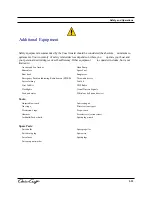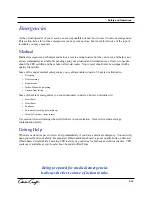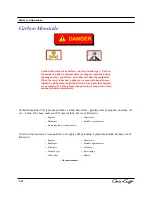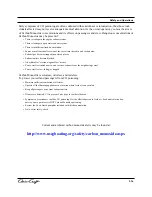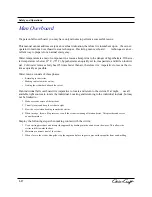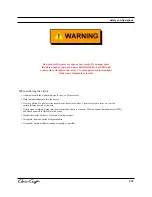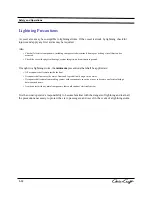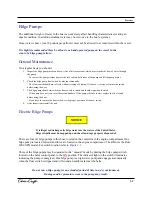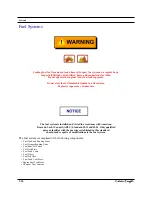
Shallow Water Dangers
The minimum depth of water you are able to run your boat is determined by several factors. The draft
is affected by the loading of the boat including the fore and aft trim, the propeller size and even by the
salinity of the water. When your boat is fully loaded, measure the maximum depth from the waterline to
the deepest point and note the number. It is the owner/operator’s responsibility to maintain a comfortable
margin over the bottom.
Should you run aground, visually check for water intrusion. If serious damage has occurred, it may
be prudent to stay aground until the damage can be assessed and controlled. After re-floating, check
the running gear for damage and feel for any unusual vibration. Perform a thorough inspection after
trailering the boat.
Running Aground
Engine cooling intakes are located under the boat. Ensure intakes are
free and clear of debris. Do not start the engines if intakes are plugged.
If you encounter shallow water and run aground:
1. Immediately place the transmissions in neutral.
2. Ensure everyone has, and is wearing, a PFD.
3. Perform a head count. Confirm everyone is present and accounted for.
4. If possible, inspect the hull, propulsion, and steering systems for damage.
5. Inspect for flooding and/or leaks.
6. If the vessel is undamaged, decide on an appropriate course of action:
– Determine the water depth and the type of obstruction you are lodged on: sand, mud, rock, etc.
– Is it possible to dislodge the vessel?
– Do you need to lighten the load by removing passengers or equipment?
– Is it possible to push the vessel off the obstruction?
– Is it possible to use reverse thrust to free the craft?
– Determine tide, current, and wind velocity. Will they help or hurt your situation?
7. If necessary, seek assistance from any nearby vessels and/or signal for help using an appropriate
signaling
device.
8. If damaged it may be safer to leave the vessel aground and seek professional help.
2-33
Safety and Operations
Summary of Contents for 2014 36 RH Corsair
Page 19: ...Introduction 36 RH Corsair B...
Page 23: ...Safety and Operations...
Page 57: ...2 36 Safety and Operations...
Page 88: ...Figure 3 26 Fluid Tank Sensor 3 30 Systems...
Page 115: ...Care and Cleaning 3 57 Systems Marine Tops And Covers Care And Cleaning...
Page 116: ...Care and Cleaning Figure 3 51 Canvas Top 3 58 Systems...
Page 118: ...Care and Cleaning 3 60 Systems Maintenance and Cleaning Of Stainless Steel...
Page 121: ...3 63 Systems Grey Water Systems Figure 3 56...
Page 126: ...Figure 3 70 Figure 3 68 3 68 Systems Figure 3 66 Figure 3 67 Figure 3 69 Cockpit Table...
Page 134: ...3 76...
Page 149: ...Coast Guard Accident Report B 2 Appendix B...
Page 150: ...Coast Guard Accident Report B 3 Appendix B...
Page 151: ...B 4 Appendix B Coast Guard Accident Report...
Page 152: ...Coast Guard Accident Report B 5 Appendix B...
Page 154: ...C 2 Appendix C SPECIAL NOTICE TO MARINERS Float Plan...
Page 155: ...Appendix C C 3 Float Plan...
Page 158: ...Navigational Aids D 3 Appendix D...
Page 159: ...Lateral Aids D 4 Appendix D...
Page 161: ...Maintenance Log Forms E 2 Appendix E...
Page 162: ...Maintenance Log Forms E 3 Appendix E...
Page 163: ...Glossary Of Boating Terminology Appendix F F 1...
Page 164: ...F 2...
Page 165: ...F 3...
Page 166: ...F 4...
Page 167: ...F 5...
Page 168: ...F 6...
Page 169: ...5 7 F 7...
Page 170: ...F 8...
Page 171: ...F 8...
Page 172: ...G 1 Figure 4 21...
Page 173: ...G 2 Figure 4 22...
Page 174: ...G 3 Figure 4 23...
Page 175: ...G 4 Figure 4 24...
Page 176: ...G 5...
Page 177: ...G 6 Figure 4 26...
Page 178: ...G 7 Figure 4 27...
Page 179: ...G 8 Figure 4 28...
Page 180: ...Figure 4 29 G 9...




